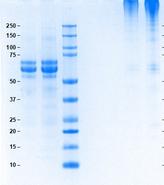
Vitronectin
Product Sizes
0.1 mg
16-16-220920-0.1MG
About this Product
- SKU:
- 16-16-220920
- Additional Names:
- VTN, VN, VTNC, S-protein, Serum-spreading factor, V75|Wound Healing, Cell Adhesion, Coagulation, Cancer, Cell Culture Media, Fibrinolysis, Glaucoma, Cardiac Fibrosis, In Vitro Diagnostic
- Application:
- Tissue Culture
- Buffer:
- Lyophilized from 10 mM sodium phosphate, pH 7.7
- CAS Number:
- 83380-82-9
- CE/IVD:
- RUO
- Extra Details:
- Vitronectin is a multifunctional glycoprotein abundantly present in blood plasma (200-400 ug/mL) and the extracellular matrix, where it plays key roles in cell adhesion, migration, tissue repair, and regulation of hemostasis. Acting as a scaffold, vitronectin supports cell attachment and spreading by binding to integrins such as A AlphavB Beta3, and it is crucial for maintaining tissue integrity, wound healing, and skin regeneration. In the circulatory system, vitronectin interacts with plasminogen activator inhibitor-1 (PAI-1), stabilizing its active form and thereby regulating fibrinolysis and clot formation. This interaction is central to controlling blood coagulation, thrombosis, and wound healing, and also modulates cell migration and angiogenesis. Altered vitronectin levels or function are implicated in several diseases. Elevated vitronectin expression is associated with increased extracellular matrix deposition, contributing to conditions such as glaucoma and cardiac fibrosis. In cancer, particularly breast cancer, higher serum vitronectin levels correlate with increased metastasis and poorer survival, making it a promising non-invasive biomarker for early detection and prognosis. Vitronectin is also involved in immune regulation and may become depleted during disseminated intravascular coagulation and liver failure313. Clinically and in research, vitronectin is widely used as a substrate in cell culture to promote cell adhesion, proliferation, and survival, especially in stem cell and regenerative medicine applications. Its versatility in supporting cell growth and tissue repair, along with its diagnostic and therapeutic potential in cancer and fibrotic diseases, underscores vitronectin's significance in both health and disease.
- Formulation:
- Lyophilized from 10 mM sodium phosphate, pH 7.7
- Molecular Weight:
- 65,000 and 75,000 Da
- Physical State:
- Lyophilized
- Purity:
- ≥95%
- Purification:
- Liquid Chromatography Methods
- Shipping Conditions:
- Blue Ice
- Source:
- Source human plasma non-reactive for HBsAG, anti-HCV, anti-HBc, and negative for anti-HIV 1 & 2 by FDA approved tests.
- Storage Conditions:
- Please refer to datasheet
- Supplier:
- Athens Research & Technology Inc.
- Type:
- Proteins, Peptides, Small Molecules & Other Biomolecules: Recombinant Proteins


